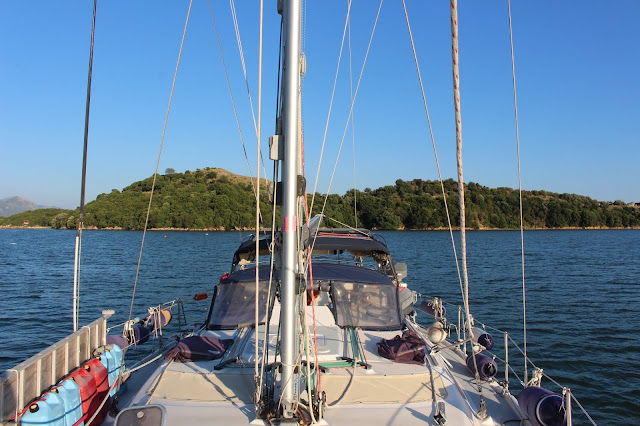Ongoing Saga: # 2
Engine Exhaust Elbow and Exhaust Hose. Another observation in the 2016 survey report recommended that an inspection of the engine exhaust elbow be conducted. A Sopromar mechanic was engaged, removed the elbow inspected, pronounced all good, but meanwhile he identified that the exhaust hose from the elbow to the muffler needed replacing. He did so but it took him a long time as it was very difficult to remove and to put in a new length as there was a bulkhead in the way and the hose is heavy duty steel reinforced rubber. Has functioned flawlessly since.
Engine Exhaust Muffler. On testing the new hose the muffler was found to be leaking at the bottom where it had been sitting against the bare fiberglass of the hull. It’s surprising it hadn’t started to leak a long time ago. The muffler was removed and, since it’s fiberglass, was repaired by the yard’s fiberglass techo. He did a great job, not only repairing the known crack but one or two others that he identified. He also glued rubber strips to the bottom so that no longer will fiberglass be sitting against fiberglass, constantly rubbing together whenever the engine is run. He also painted it so that it looked like a brand new one.
Fresh Water Flusher for Engine's Water Intakes. I purchased and used several times a fresh water flusher, something I could manage myself, for use when the boat is out of the water. The flusher is a standard purchase and it looks like an enormous ‘plumber’s mate that you use for unblocking drains or your toilet. Its mounted on some block of wood etc on the ground with the flush fitting covering the thru-hull fitting eg engine water intake. You then attach a hose to the flush fitting and the other end to a tap. When you start your engine you immediately turn on the tap and run the engine with the water intake more or less as normal.
I set up the hose so that I could do it myself on board by running the hose from the tap into a on/off valve in the cockpit then over the side to the flush fitting. I start by closing the valve, then I turn on the tap, get back on board, start the engine, then open the valve, then check exhaust for water coming out. Before turning off the engine, I turn off the valve first, turn off engine after a short pause as water still keeps coming out the exhaust for some short time. I then turn off the tap. Love it.
Engine Exhaust Muffler. On testing the new hose the muffler was found to be leaking at the bottom where it had been sitting against the bare fiberglass of the hull. It’s surprising it hadn’t started to leak a long time ago. The muffler was removed and, since it’s fiberglass, was repaired by the yard’s fiberglass techo. He did a great job, not only repairing the known crack but one or two others that he identified. He also glued rubber strips to the bottom so that no longer will fiberglass be sitting against fiberglass, constantly rubbing together whenever the engine is run. He also painted it so that it looked like a brand new one.
Fresh Water Flusher for Engine's Water Intakes. I purchased and used several times a fresh water flusher, something I could manage myself, for use when the boat is out of the water. The flusher is a standard purchase and it looks like an enormous ‘plumber’s mate that you use for unblocking drains or your toilet. Its mounted on some block of wood etc on the ground with the flush fitting covering the thru-hull fitting eg engine water intake. You then attach a hose to the flush fitting and the other end to a tap. When you start your engine you immediately turn on the tap and run the engine with the water intake more or less as normal.
I set up the hose so that I could do it myself on board by running the hose from the tap into a on/off valve in the cockpit then over the side to the flush fitting. I start by closing the valve, then I turn on the tap, get back on board, start the engine, then open the valve, then check exhaust for water coming out. Before turning off the engine, I turn off the valve first, turn off engine after a short pause as water still keeps coming out the exhaust for some short time. I then turn off the tap. Love it.
 |
| An exciting view of a flushing engine...hmmm! |









